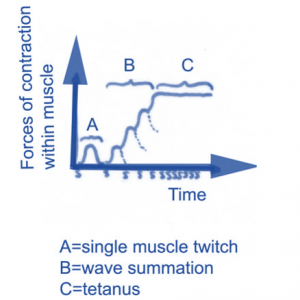The ‘All or None’ Law
Each fibre within a motor unit contracts according to the all or none law. This principle states that when a motor unit receives a stimulus of sufficient intensity to bring forth a response, all the muscle fibres within the unit will contract at the same time, and to the maximum possible extent. If, however, the stimulus is not of sufficient intensity, the muscle fibres will not respond, and contraction will not take place.
The degree to which a muscle contracts is dependent on several factors, including the number of motor units recruited by the brain. This will determine the force that can be generated within the muscle. The greater the strength required, the greater the number of motor units (and therefore the number of muscle fibres) that contract.
For example, more motor units will be recruited in the biceps brachii when performing the bicep curl with a heavy dumbbell, than when performing the same exercise with an egg.
This process can sometimes deceive us. For instance, when lifting a box that appears to be light, not enough motor units are recruited, and the box cannot be lifted. When trying a second time, the box is easily lifted because this time enough motor units have been recruited. Alternatively, when attempting to lift a box that appears to be heavy (but in fact is not), an explosive movement often occurs, as too many motor units have been recruited for the task.
A second concern is the frequency with which impulses arrive at the muscle fibres. The motor unit will respond to a stimulus by giving a ‘twitch’ (a brief period of contraction followed by relaxation). When a second impulse is applied to the motor unit before it completely relaxes from the previous stimulus, the sum of both stimuli occurs, increasing the total contraction. This process is known as multiple wave summation. When rapid firing of stimuli occurs, giving muscles little or no time for relaxation, tetanus or tetanic contraction occurs, increasing the total contraction still further. This increase in total contraction can be explained by the increased release of calcium ions which causes greater cross bridge attachment of myosin onto actin.

